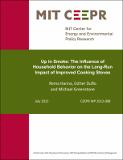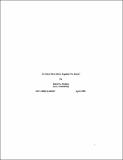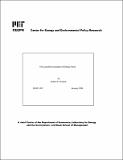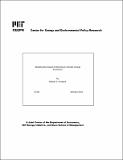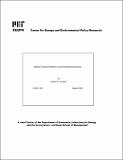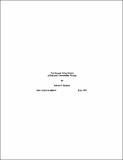Browsing Working Papers by Author "Pindyck, Robert S."
Now showing items 1-20 of 26
-
The Climate Policy Dilemma
Pindyck, Robert S. (MIT CEEPR, 2012-07)Climate policy poses a dilemma for environmental economists. The economic argument for stringent GHG abatement is far from clear. There is disagreement among both climate scientists and economists over the likelihood of ... -
Do stock prices move together too much?
Pindyck, Robert S.; Rotemberg, Julio (MIT Center for Energy and Environmental Policy Research, 1990)We show that comovements of individual stock prices cannot be justified by economic fundamentals. This finding is a rejection of the present value model of security valuation. Unlike other tests of this model, ours is ... -
The dynamics of commodity spot and futures markets
Pindyck, Robert S. (MIT Center for Energy and Environmental Policy Research, 2001)I discuss the short-run dynamics of commodity prices, production, and inventories, as well as the sources and effects of market volatility. I explain how prices, rates of production, and inventory levels are interrelated, ... -
The Economic and Policy Consequences of Catastrophes
Pindyck, Robert S. (MIT Center for Energy and Environmental Policy Research, 2009-09)What is the likelihood that the U.S. will experience a devastating catastrophic event over the next few decades – something that would substantially reduce the capital stock, GDP and wealth? What does the possibility of ... -
Economic instability and aggregate investment
Pindyck, Robert S.; Solimano, Andrés (MIT Center for Energy and Environmental Policy Research, 1993)A recent literature suggests that because investment expenditures are irreversible and can be delayed, they may be highly sensitive to uncertainty. We briefly summarize the theory, stressing its empirical implications. We ... -
Expandability, reversibility, and optimal capacity choice
Dixit, Avinash K.; Pindyck, Robert S. (MIT Center for Energy and Environmental Policy Research, 1997)We develop continuous-time models of capacity choice when demand fluctuates stochastically, and the firm's opportunities to expand or contract are limited. Specifically, we consider costs of investing or disinvesting that ... -
Fat Tails, Thin Tails, and Climate Change Policy
Pindyck, Robert S. (MIT Center for Energy and Environmental Policy Research, 2010-09)Climate policy is complicated by the considerable compounded uncertainties over the costs and benefits of abatement. We don’t even know the probability distributions for future temperatures and impacts, making cost-benefit ... -
Inventories and the short-run dynamics of commodity prices
Pindyck, Robert S. (MIT Center for Energy and Environmental Policy Research, 1990)I examine the behavior of inventories and their role in the short-run dynamics of commodity production and price. Competitive producers of a storable commodity react to price changes by balancing costs of changing production ... -
Investments of uncertain cost
Pindyck, Robert S. (MIT Center for Energy and Environmental Policy Research, 1992)I study irreversible investment decisions when projects take time to complete, and are subject to two types of uncertainty over the cost of completion. The first is technical uncertainty, i.e., uncertainty over the amount ... -
Irreversibilities and the timing of environmental policy
Pindyck, Robert S. (MIT Center for Energy and Environmental Policy Research, 1999)The Standard framework in which economists evaluate environmental policies is cost-benefit analysis, so policy debates usually focus on the expected flows of costs and benefits, or on the choice of discount rate. But this ... -
Irreversibility and the explanation of investment behavior
Pindyck, Robert S. (MIT Center for Energy and Environmental Policy Research, 1990)The explanation of aggregate and sectoral investment behavior has been one of the less successful endeavors in empirical economics. Existing econometric models have had little success in explaining or predicting investment ... -
Irreversibility, uncertainty and investment
Pindyck, Robert S. (MIT Center for Energy and Environmental Policy Research, 1990)Most investment expenditures have two important characteristics. First, they are largely irreversible; the firm cannot disinvest, so the expenditures are sunk costs. Second, they can be delayed, allowing ... -
The long-run evolution of energy prices
Pindyck, Robert S. (MIT Center for Energy and Environmental Policy Research, 1999)I examine the long-run behavior of oil, coal, and natural gas prices, using up to 127 years of data, and address the following questions: What does over a century of data tell us about the stochastic dynamics of price ... -
A markup interpretation of optimal rules for irreversible investment
Dixit, Avinash K.; Pindyck, Robert S.; Sødal, Sigbjørn (MIT Center for Energy and Environmental Policy Research, 1997)We re-examine the basic investment problem of deciding when to incur a sunk cost to obtain a stochastically fluctuating benefit. The optimal investment rule satisfies a trade-off between a larger versus a later net benefit; ... -
Modeling the Impact of Warming in Climate Change Economics
Pindyck, Robert S. (MIT Center for Energy and Environmental Policy Research, 2010-01)Any economic analysis of climate change policy requires some model that describes the impact of warming on future GDP and consumption. Most integrated assessment models (IAMs) relate temperature to the level of real GDP ... -
The new option view of investment
Dixit, Avinash K.; Pindyck, Robert S. (MIT Center for Energy and Environmental Policy Research, 1995)This paper provides a simple introduction to the new option view of investment. We explain the shortcomings of the orthodox theory, and then outline the basic ideas behind the option framework. Several industry examples ... -
A note on competitive investment under uncertainty
Pindyck, Robert S. (MIT Center for Energy and Environmental Policy Research, 1991)This paper clarifies how uncertainty affects irreversible investment in a competitive market equilibrium. With free entry, irreversibility affects the distribution of future prices, and thereby creates an opportunity cost ... -
Optimal timing problems in environmental economics
Pindyck, Robert S. (MIT Center for Energy and Environmental Policy Research, 2001)Because of the uncertainties and irreversibilities that are often inherent in environmental degradation, its prevention, and its economic consequences, environmental policy design can involve important problems of timing. ... -
The present value model of rational commodity pricing
Pindyck, Robert S. (MIT Center for Energy and Environmental Policy Research, 1991)The present value model says that an asset's price equals the sum of current and future discounted expected future payoffs from ownership of the asset. I explore the limits of the present value model by testing its ability ... -
Risk and Return in Environmental Economics
Pindyck, Robert S. (MIT CEEPR, 2012-07)I examine the risk/return tradeoff for environmental investments, and its implications for policy choice. Consider a policy to reduce carbon emissions. To what extent does the value of such a policy depend on the expected ...
